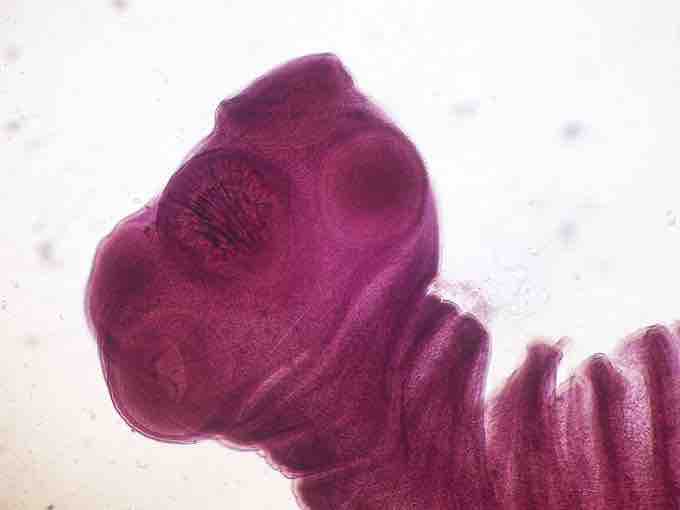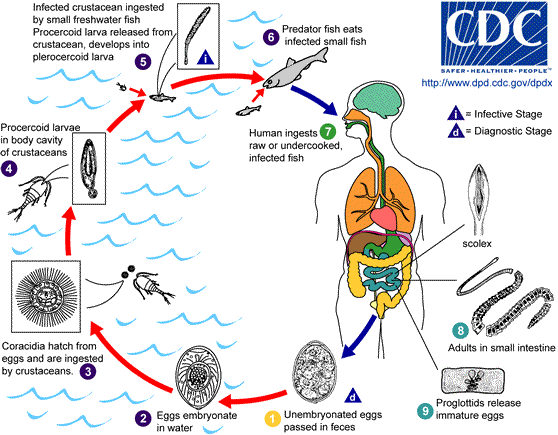Tapeworms are characterized as adult parasitic flatworms that target and infect the digestive tract. Typically, transmission occurs by ingestion of a live tapeworm larva which is found in undercooked or contaminated food. Once inside the digestive tract, the larvae can then grow and develop into a large tapeworm. There are various types of tapeworms identified to date that are capable of infecting humans. A few common tapeworms include the pork tapeworm (Taenia solium), the beef tapeworm (Taenia saginata), and the fish tapeworm (Diphyllobothrium spp. ).
Taenia solium
Taenia solium, the pork tapeworm, infects both pigs and humans. Humans are typically infected by ingesting infected pork. Taenia solium will target the intestinal area in humans. Using the four suckers and two rows of hooks present on its scolex, it lodges itself against the intestinal wall. Once anchored, the tapeworm continues to grow in the intestine and will pass its eggs through the feces. When Taenia solium is in its larval stage, it is referred to as a cysticercus and can cause cysticercosis. Cysticercosis occurs when the cysticerci reach the central nervous system and cause neurological issues .

Scolex of the Taenia solium
An image of the scolex of the Taenia solium.
Taenia saginata
Taenia saginata, the beef tapeworm, is capable of infecting both cattle and humans. Infection by Taenia saginata is referred to as taeniasis in humans and occurs by ingestion of contaminated meat that has been improperly handled. Taeniasis is caused by the ability of the tapeworm to lodge itself in the small intestine of the human and release fertilized eggs through the feces. The eggs can then infect cattle upon ingestion. Upon infection of the cattle, the fertilized eggs will develop into zygotes which will exit the digestive tract and enter into the circulatory system. The larval stages will then form cysts, referred to as Cysticercus bovis, within the muscular system of the cattle. Therefore, if humans ingest under prepared meat with cysts, the cysts will break open into the digestive system and develop into an adult tapeworm in the human host .

Tapeworm
An adult Taenia saginata.
Diphyllobothrium spp.
Diphyllobothrium spp, the fish tapeworm, encompasses various species that can infect humans upon ingestion of under cooked or raw fish. For example, these tapeworms include those found on broad fish and salmon. Interestingly, only a few species of these tapeworms are found to infect humans on a frequent basis. The tapeworms found in fish exhibit the ability to also infect canines, felines, bears, and mussels.
The life cycle for fish tapeworms includes movement through numerous hosts. The mammal host is considered the definitive host as this is the site of worm reproduction. The immature eggs are passed through the feces of the mammal host and then infect a freshwater host. This freshwater host is considered to be the intermediate host. The intermediate host is then ingested by a second intermediate host which includes the fish. The larvae, which developed in the first intermediate host, then migrate out into the flesh of the fish (the second intermediate host). The larvae develop into a more mature form and constitute the infective stage for the definitive host. It is important to note that many second intermediate hosts are ingested by larger predator species that are utilized as a food source for humans. Therefore, it is not necessary for humans to directly eat the second intermediate host in order to be infected .

Diphylloborthrium latum life cycle
Overview of the life cycle of Diphylloborthrium latum. Note the various hosts which are necessary for successful transmission.